From Bologna to Salerno - Exploring Pompeii (6/9)
Pompeii
When one travels to Naples, Pompeii, the magnificent Roman city, is a must-visit. The best way to get there is with the Circumvesuviana. You need to take the blue train line, which travels to Sorrento. More or less half way along the line the stop Pompei Scavi Villa dei Misteri is located, where, only a few metres to the right of the exit from the station, is the entrance to the city. The journey lasts around 30 minutes, but honestly it feels like an eternity, and there's barely any fresh air and the train is always super full... we were like sardines in a tin can! Be careful and pay attention during the journey, as not all the metro stops appear on the map. The ticket price varied depending on the station we went to: going from Naples Central Station or Napoli Garibaldi to Pompeii Scavi, the return ticket was €5. 60.
You can buy the tickets to access the archaeological city from the ticket office itself, but I recommend buying them beforehand online, as there are usually less people in the queue for online purchases. Once you've shown the receipt and have collected the original tickets there, then you can walk around the Roman streets of Pompeii. If you want to visit the city, I advise having comfortable clothing, cold water and sun cream, because there's hardly any shade and the sun, at least in mid June, is scorching.
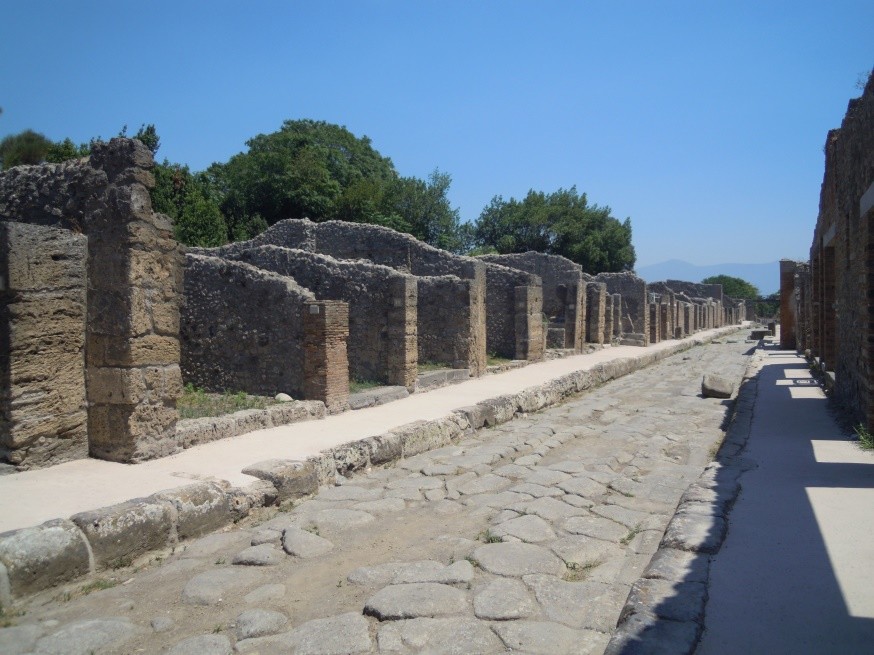 A street in Pompeii
A street in Pompeii
Pompeii is a very big city, and at the information point (in the ticket offices), where you can also get an audio guide, they can provide you with a plan of the city. If you're very interested in the Ancient World, you will need at least 4 or 5 hours to get to know the city and, even then, there will still be some corners you won't have visited!
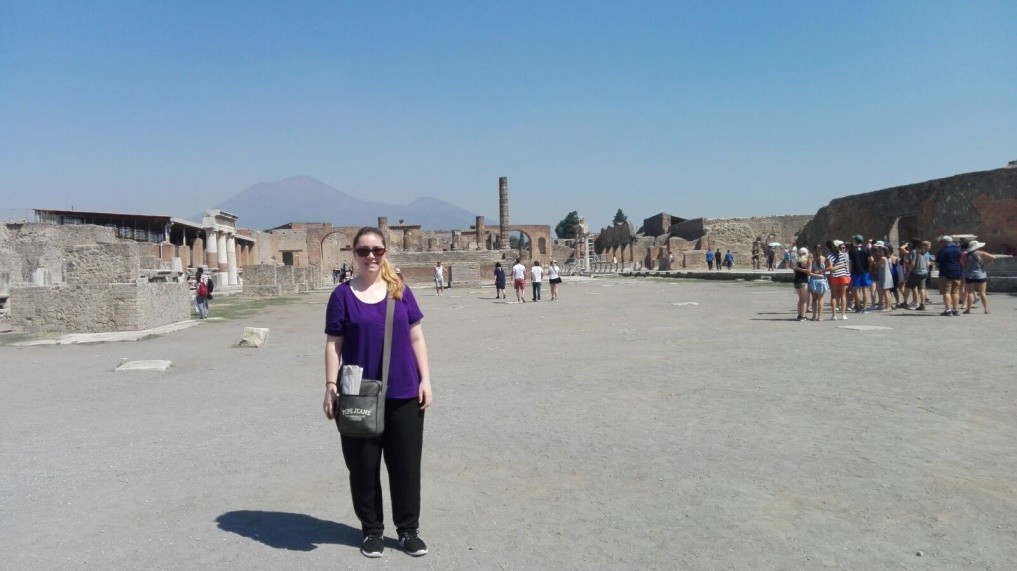 In Pompeii's Forum, with Vesuvius in the background
In Pompeii's Forum, with Vesuvius in the background
The volcano Vesuvius is one of Earth's most dangerous volcanoes and is particularly famous for the discovery of the cities of Pompeii, Herculaneum, Oplontis, Stabiae: Roman cities that were buried due to a volcanic eruption preceded by an earthquake that began on the 24th August in the year 79 AD.
The citizens of Pompeii found eternal sleep, enshrouded in a layer of stone, the last moment of their lives captured forever. The events were recorded by Pliny the Younger in his Letters to Tacitus. Pliny the Younger witnessed the catastrophe from Misenum, while his uncle, Pliny the Older, moved by his curiosity and thirst for knowledge, travelled by boat towards the site of the eruption:
"Your request that I would send you an account of my uncle’s death (... ) he perished by a misfortune, which, as it involved at the same time a most beautiful country in ruins (... ) He was at that time with the fleet under his command at Misenum. On the 24th of August, about one in the afternoon, my mother desired him to observe a cloud which appeared of a very unusual size and shape. (... ) Hastening then to the place from whence others fled with the utmost terror, he steered his course direct to the point of danger, and with so much calmness and presence of mind as to be able to make and dictate his observations upon the motion and all the phenomena of that dreadful scene. (... ) As soon as it was light again, which was not till the third day after this melancholy accident, his body was found entire, and without any marks of violence upon it, in the dress in which he fell, and looking more like a man asleep than dead. (... )"
How did the life of the people of Pompeii end? A stream of lava would have taken up to 6 days to reach the city, so it would have given them time to escape. Death by suffocation was also a possibility, as shown below in the figure covering his nose and mouth with his hands; however, a person who suffers an agonising death of suffocation, falls to the ground in any position and does not remain petrified randomly in that way.
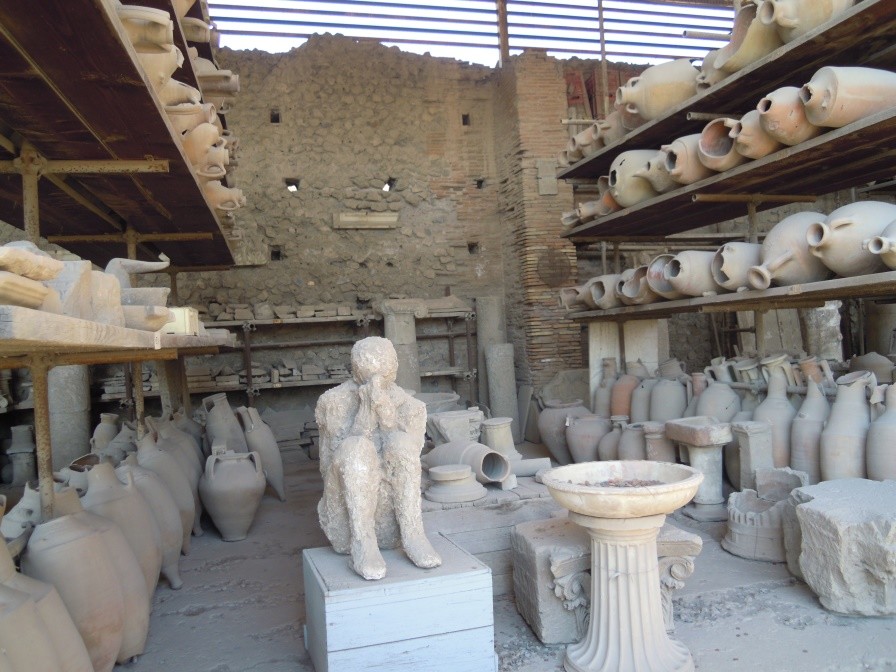 Barns with amphoras and figure covering his nose and mouth
Barns with amphoras and figure covering his nose and mouth
Pompeii is the only ancient city of which its topographic structure is accurately known, without subsequent alterations. When we arrive at the Roman city, the first place that we'll cross will be the Marina Gate, through which one can reach the Forum, the city centre, where an imposing sculpture of a centaur stands out. Next we'll find the Temple of Apollo.
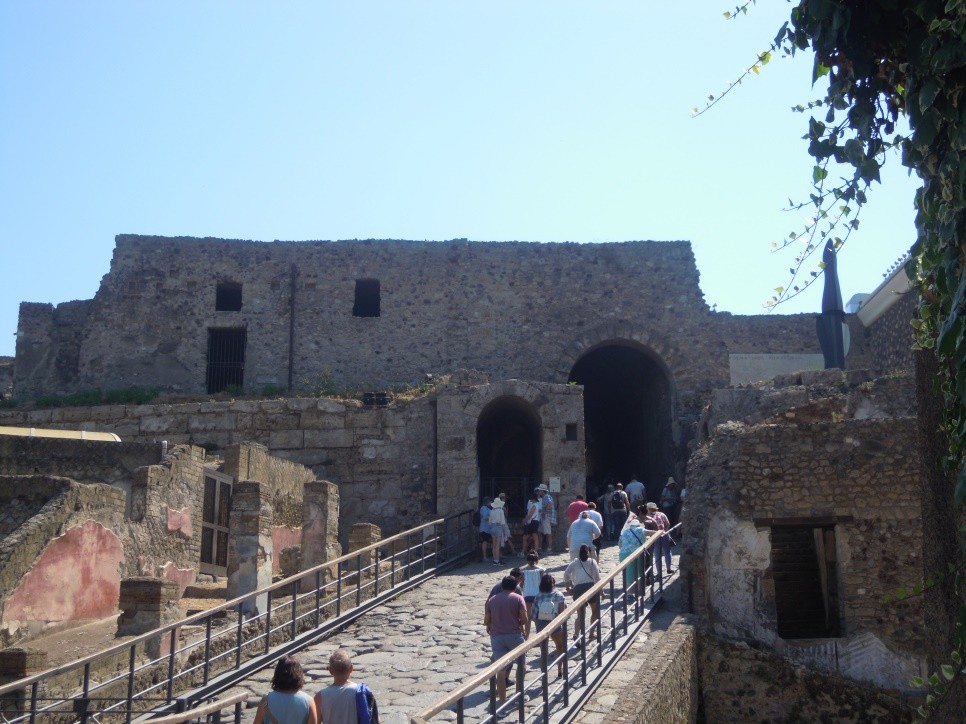 Marina Gate, entrance to Pompeii
Marina Gate, entrance to Pompeii
On the other side, there's the Basilica, where trials and business deals took place, and a little further the Temple of Venus would be located, a place that is currently being excavated. Nevertheless, the most notable sacred space in Pompeii is the Temple of Jupiter; although there are many others, like the Temple of Vespasian, the Sanctuary of Lares, the Temple of Fortuna Augusta or the Temple of Isis.
 The Temple of Isis
The Temple of Isis
As for the markets (macella), there are many "tabernae" of shopkeepers in different streets of the city. On the other hand, the several Baths also stand out, where you can distinguish the apodyterium (changing room), the frigidarium (cold water pool), the tepidarium (warm water pool) and the calidarium (hot water pool). Continuing with leisure or "otium", there's also a brothel in the city, the lupanar, where they've discovered several frescos with erotic scenes.
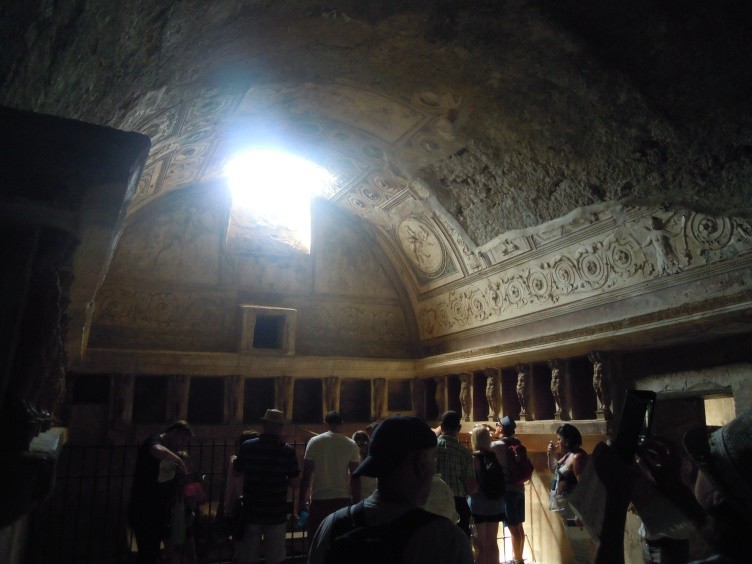
Inside the Baths
Another public space in Pompeii was the Triangular Forum, near to which was the Large Theatre, where, at least according to the posters in the area, they will soon start putting on festivals of ancient theatre. In addition, there was an Odeon where they had concerts and small shows.
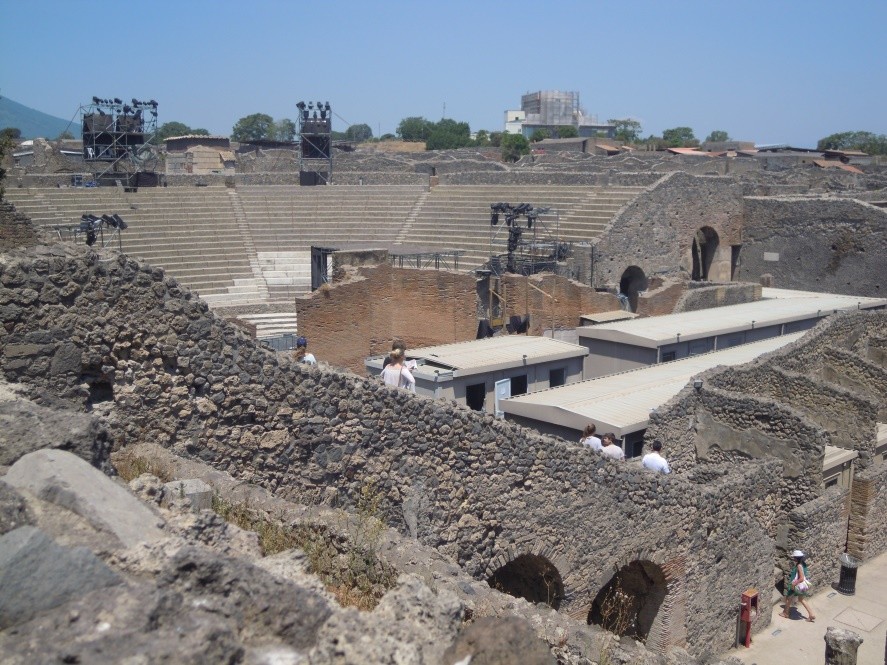 View of the Theatre and other Pompeian remains
View of the Theatre and other Pompeian remains
The Palaestra is also prominent, where the youth practised the art of callisthenics; it's a pity that it wasn't open to the public. A little further the Amphitheatre is located, which is the oldest that has been excavated.
 The Amphitheatre of Pompeii
The Amphitheatre of Pompeii
Carrying on to the private domain, there are several houses in Pompeii that can be visited and that have preserved mosaics and frescos. Such is the case of the House of the Poet, where one can see a mosaic of a tied-up dog and the inscription "Cave Canem"; House of the Faun, where the mosaic of Alexander the Great was found; House of the Vetii, which contains many mythological paintings;
House of Venus, where the goddess appears traversing the sea on a shell with two cupids; House of Menander, with paintings that refer to the Iliad; Villa of the Mysteries, where the Dionysian Mysteries are depicted together with Dionysus and Ariadna.
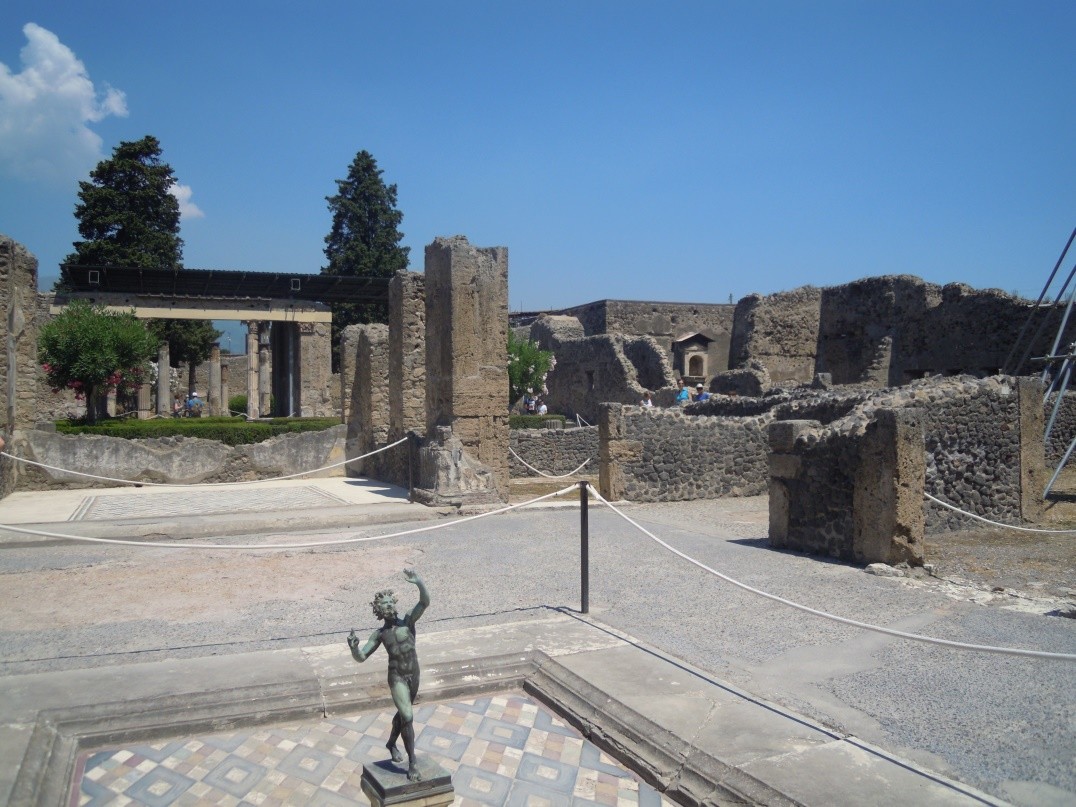 Details in the House of the Faun
Details in the House of the Faun
In addition, you can eat on the premises and there are different recycling points and bins to keep this space clean, a World Heritage Site. Also there's a fast food and drinks restaurant in the city centre, just next to the forum. Concerning the bathrooms, these are only in the entrance, in the ticket office.
The only inconvenience in Pompeii is that some houses and spaces are closed to the public at some times during the day; some are only open in the morning, whereas others are only accessible from 1:45pm.
To get back to Naples from the city of Pompeii, you have to go to Platform 2, where the trains depart towards Naples every 20-30 minutes. Don't forget to validate the tickets before!
Next stop: Herculaneum
Photo gallery
Content available in other languages
Want to have your own Erasmus blog?
If you are experiencing living abroad, you're an avid traveller or want to promote the city where you live... create your own blog and share your adventures!
I want to create my Erasmus blog! →
























Comments (0 comments)